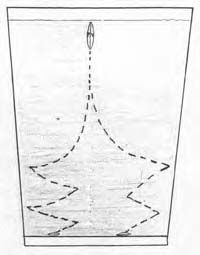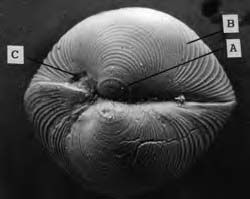|
In an unguarded moment I said to Jan Light “One of the best things I ever did was to join the Conch. Soc,”: I meant - from a palaeontological point of view. She suggested writing an article for Mollusc World giving reasons why. So Jan is partly to blame. The other ‘guilty’ party was Cyril Castell, one time member now sadly not with us. He told me “If you want to understand fossil molluscs you should study the living ones”. It was the sort of thing one shouldn’t need to be told, that there is more to a fossil mollusc than its stratigraphical level and its temporal implications: and he invited me to attend a Conch. Soc. meeting which, then, was held in the Board Room of the Brit, Mus. (Nat. Hist.) as it was then called. He said “Bring your bucket of water along”. I was introduced and duly nominated for membership and, during the session on ‘member's exhibits’, I was invited to demonstrate my experiments with the bucket of water. I had made four plaster models of the Middle Jurassic ammonite Leioceras opalinum, each loaded with increasing quantities of lead. Each was held vertically with the sharp ventral edge just touching the water surface and then released. The different weights, I argued, gave increasing velocities equivalent to a propulsive force applied by the ammonite when jetting water from its funnel. It was then widely held that some oxycone ammonites darted around the Jurassic sea, propelled by water squirted from its, presumed, funnel. The purpose of the experiment was to show that, if an ammonite jetted water from its funnel, the disc-like shape was all wrong for under water propulsion. No one argued against the idea of different weights being equivalent to different propulsive forces, so I was encouraged. I let go of the lightest model and down it went, edge first. About four inches down it started to turn until it was horizontal and continued in a zig-zag manner to the bottom (Fig.1). This will be familiar to anyone who has thrown a coin in a fountain and seen it zig-zag to the bottom. Ships do the same under a propulsive force and deviate from a straight line, it is called ‘yawing’. Repeated release of the models showed the same tendency, to turn and zig-zag, but the heaviest almost reached the bottom before turning and did one ‘zig’ before hitting the bottom. Apart from one try which went straight down without yawing, they all turned and zig-zagged. “So”, I argued “if the ammonite applied a propulsive force through its funnel, it would move in the opposite direction but turn away from a straight line, a pointless manoeuvre for chasing a prey or escaping a predator. Everyone seemed to agree and a set of probing questions prodded me into thinking less about hydrostatics and more about the ammonite as a living animal. “If it wasn’t for propulsion, what was the funnel for?” I could only say “respiration”, its primary function. “What was the chambered section of the shell for?”. “Changing buoyancy” I answered, still in hydrostatic mode. Then Cyril said “If it cannot move horizontally, all it can do is go up and down - why? “. There was a long silence as the mental gears turned. Then the ‘penny dropped’, and I moved from physics to biology and offered the hypothesis that ammonites sank down with the zooplankton, while phytoplankton was photosynthesising during daylight. Then they rose at night, with other animals which 'grazed' on the plants. The separation of animals and plants during daylight was, then, well known. Even I knew it but had forgotten and did not realise it could be applied to palaeontology. Someone, bless him, said “you can’t prove that”. True, but I still hold that it is a reasonable hypothesis, but now more complex than I believed at the time. And so, with a bucket of water, a few plaster models and knowledge of the diurnal movement of zooplankton, together with some sharp questions from Conch. Soc. members I moved from physics to biology and found that Cyril was right about learning from living organisms. Years later, Adrian Rundle collected a sample of Upper Jurassic Kimmeridge Clay from Ringstead Bay, Dorset. After washing away the clay, he was left with a residue of the usual ostracods, forams, broken shell debris, and minute single, and articulated, bivalve shells. Adrian generously gave me part of his dried sample and said that I would find some interesting larval shells in it. He was right, they were oyster larval shells. The preservation was amazing, single valves showing teeth, and a minute articulated pair, O.3mm, with a complete posttrochophore history recorded in its shell. Tom Waller had published a paper on the post-trochophore development of living Ostrea edulis and Crassostrea gigas, superbly illustrated with scanning electron micrographs, from which I was able to ‘read’ the larval shells I had. An oyster larva goes through all the stages from a bundle of cells to organ differentiation. Fig. 2 shows: A the first shell formed after the larva changes from a trochophore to a veliger. It is made of a single sheet of calcite; B shows growth increments getting crowded as the larva continues growing but not yet feeding; C shows a slot in the left valve in exactly the same position as shown in a larval shell illustrated by Waller. At some genetically determined stage, the blind-ended gut becomes a through alimentary track, mouth at one end, anus at the other. Only then does it begin feeding in the plankton (planktotrophic). The Kimmeridge Clay shells showed the exact position on the shell when the larval gut developed as a through tube and began feeding in the plankton. It is priceless moments like these which would be impossible without knowledge of the living analogues, or descendents, and their behaviour. Charles Lyell's dictum “The present is the key to the past” is as true today as it was in the middle of the 19th century. |
Fig. 1: The Bucket
Fig. 2: Kimmeridge Clay, bed 6, Ringstead Bay, Dorset |
On joining the Conch Soc.
Issue
11
Page
21


